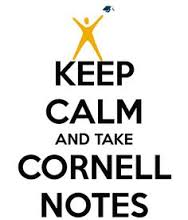Bridging the Gap: Using Cornell Notes in the Foundations Classroom
Lark S. EscobarIn my previous Bridging the Gap article about using iPads to boost academic and language skills, we looked at how to use familiar technology to promote broad skill development in areas that may be weaknesses for foundations students. As we all know, foundations students are joining college with big gaps in academic skills. This means that some learners may not have had a lot of experience, or even any, with note taking in the classroom. It’s our job as educators to fill these gaps.
While there are many methods and approaches that can facilitate skill development, a particularly tried-and-true method that I’ve had success with in my classroom is the Cornell Notes method.
Click HERE or HERE for additional tutorials about using Cornell Notes in various content areas.
Click HERE for Cornell Notes in MATHS classes.
What are the benefits of using Cornell Notes with my Foundations students?
Cornell  Notes will probably be totally unfamiliar to your learners and it may require 4 or 5 times of whole-class practice to really develop a desired level of comfort with using this system. You may wonder if it is worth suffering through the practice with them, but with a little patience, the students learn how to pay attention to what they are reading. They begin to discern between details and main ideas, and they cultivate their ability to summarize. Moving beyond discrete-point learning helps prepare them for their academic future as they start using college-level study skills. It is impossible to do Cornell Notes without actively listening or reading, and students also become more engaged when they can show what they know. This fresh confidence and pride can really go along way in the classroom, creating energy and impetus for trying more new skills and building trust between the teacher as mentor and the students.
Notes will probably be totally unfamiliar to your learners and it may require 4 or 5 times of whole-class practice to really develop a desired level of comfort with using this system. You may wonder if it is worth suffering through the practice with them, but with a little patience, the students learn how to pay attention to what they are reading. They begin to discern between details and main ideas, and they cultivate their ability to summarize. Moving beyond discrete-point learning helps prepare them for their academic future as they start using college-level study skills. It is impossible to do Cornell Notes without actively listening or reading, and students also become more engaged when they can show what they know. This fresh confidence and pride can really go along way in the classroom, creating energy and impetus for trying more new skills and building trust between the teacher as mentor and the students.
Tips for Using Cornell Notes in Foundations Classrooms 
My lessons learned may not be applicable to all levels of learners and content areas offered at the various HCT locations, but in case this information is helpful here are my tips and tricks for Cornell Notes success:
- Modelling the system with the class may take 3-5 sessions before learners are ready to approach the task independently. Also, at times, I reward correct answers or close answers with chocolate to help learners maintain motivation and enjoy their micro-successes.
- As students attempt to complete the task with assigned reading, I monitor their work. Learners with correct answers are invited to share their work on the board with the class. This motivates more reluctant learners to try and publicly reinforces the success of those who worked it out on their own.
- This is a great opportunity for pair-work, particularly if you want to pair weaker ability levels with stronger ability level students. They can talk through their thinking process together and share their skills in a low-risk high-reward environment.

Cautionary note: this task can be completed via PDF on iPad, but students may be inclined to recycle their classmate’s work instead of attempting it on their own as digital sharing can be a little too convenient. Also, something to consider is that the act of writing is more productive in terms of language acquisition than the act of typing.

